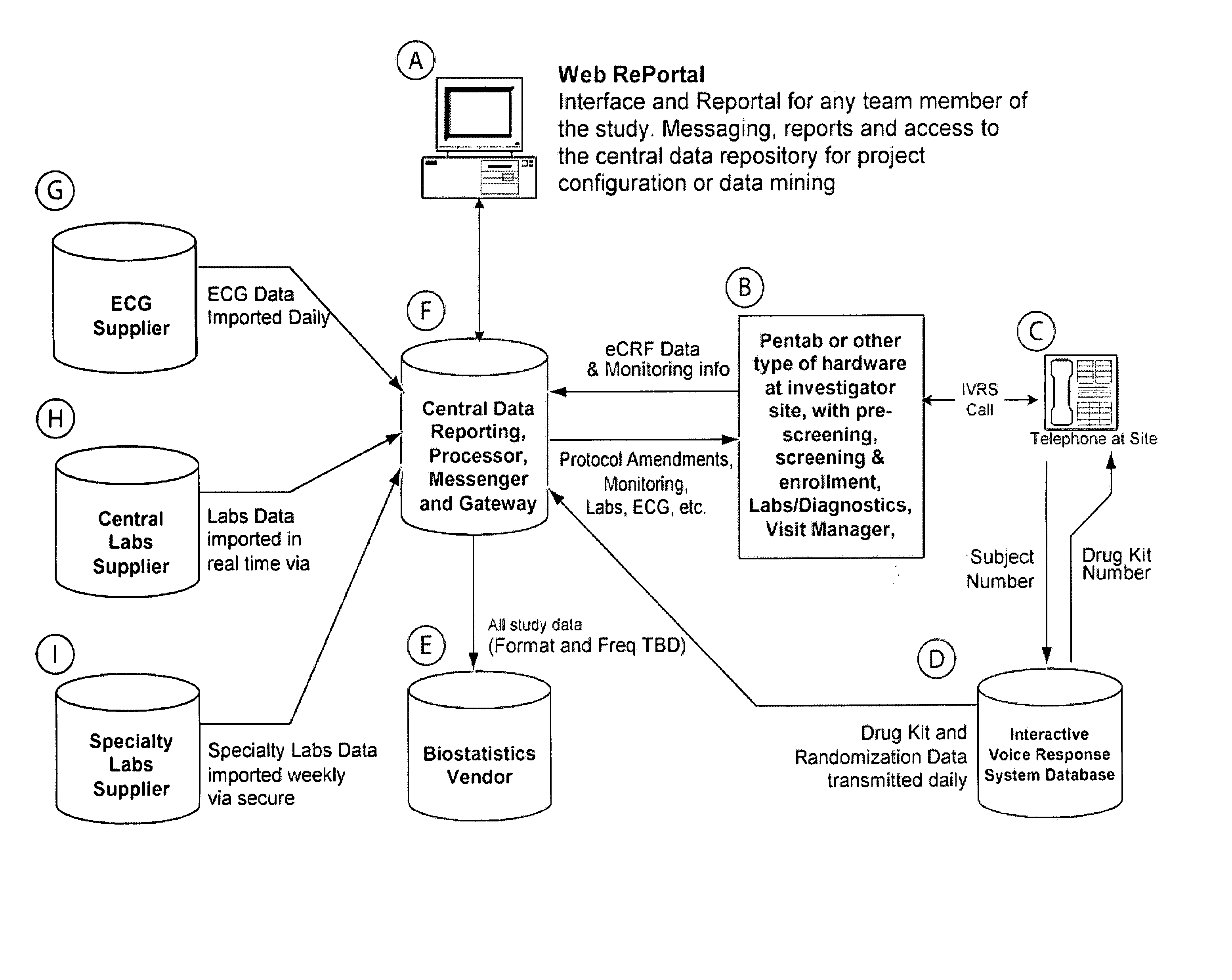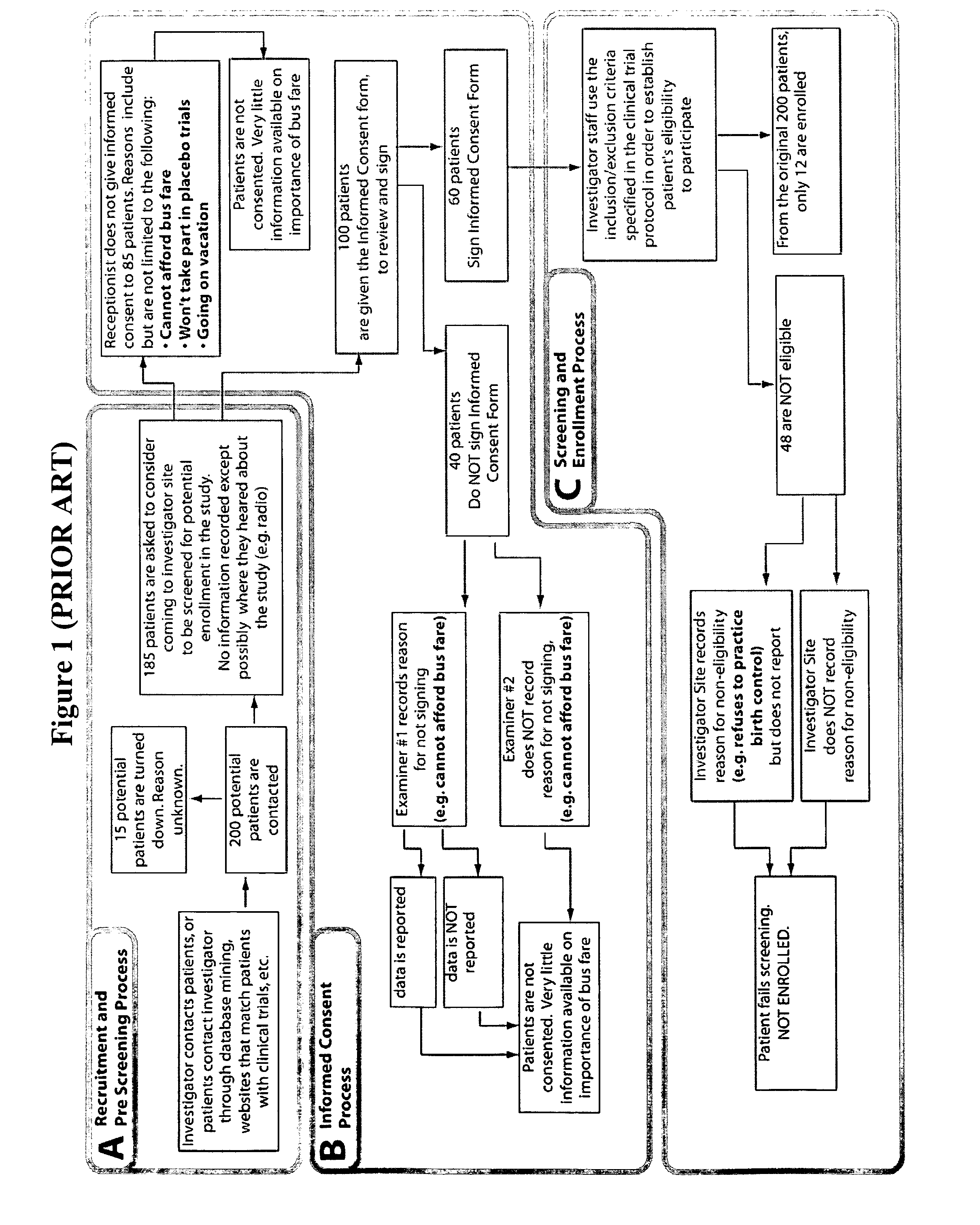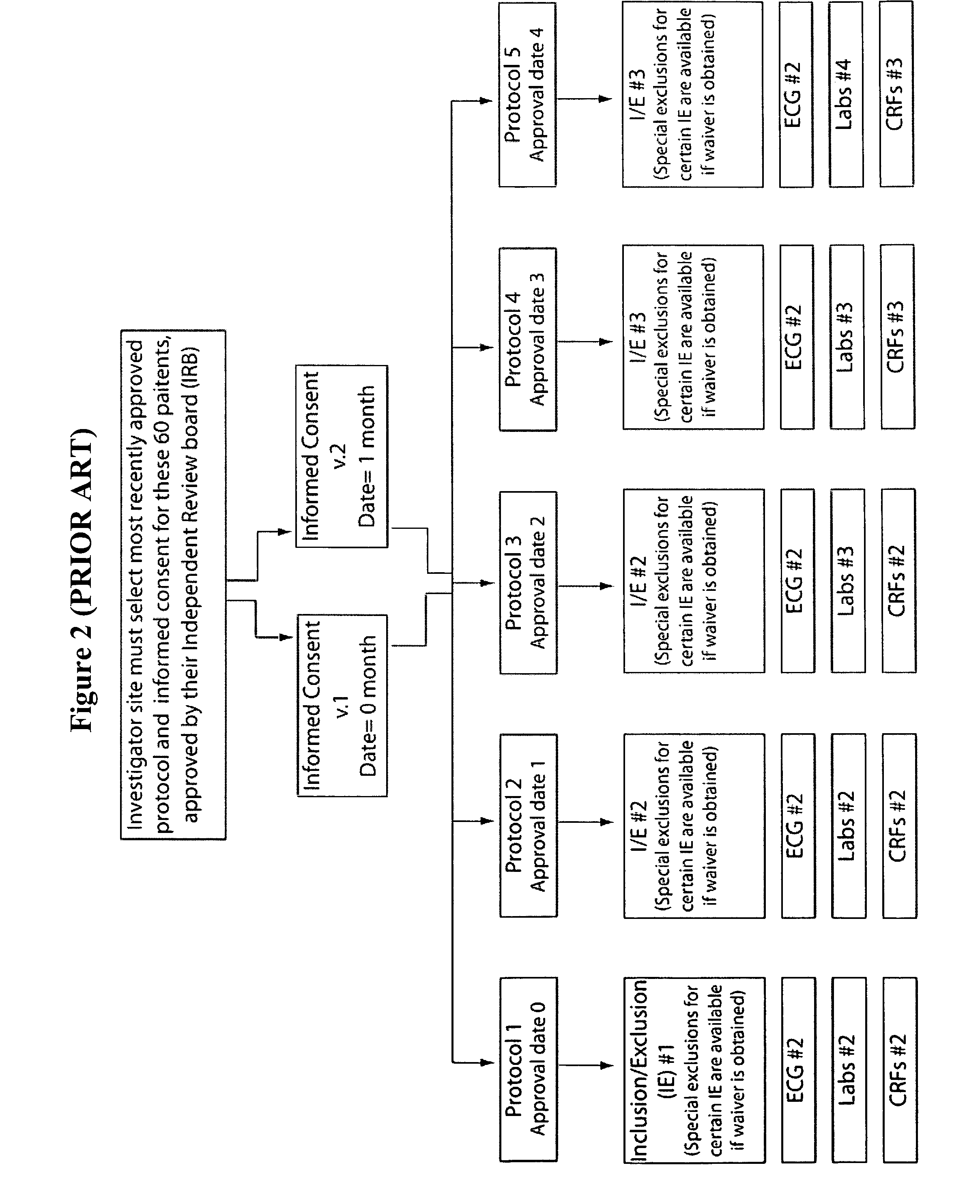[0016] An integrated, interactive and dynamic, screening and enrollment
management system is provided that handles the logistics of
information management for patients that have been recruited for a clinical trial. The present invention is an
information management system and method for pharmaceutical, biotech,
medical device diagnostics companies,
clinical research organizations, recruitment companies, clinical investigation centers, registries, and marketing companies that simplifies, speeds, and improves the accuracy of the screening and enrollment process for clinical trial patients. The present invention performs real-time harnessing and consolidation of information and data from any and all systems, participants and groups that are part of the process (e.g. ECG, labs,
specialty labs, IVRS, other diagnostic testing, clinical monitors, investigator sites, etc.). The present invention standardizes all the data from any
system, and then reconciles the data against all other data within the
system. All data are processed with algorithms that are specific to a trial protocol and accepted values, and with estimated
metrics for the trial. The present invention sends the data that does not reconcile, into reports and then messages the appropriate party that an inconsistency exists. These messages and reports provide that party with a proposed solution to solve the discrepancy. The present invention also displays trends in the screening and enrollment and provides possible solutions. The present invention tracks patients that have not qualified based on a set of criteria, and display the criteria under which the patient will qualify.
[0017] The present invention is an integrated, interactive, screening and enrollment
management system that solves the problems of screening and enrollment of patients that have already been recruited for specific trials that are being conducted at investigative sites. This is an advancement of the current methods. It takes the very complicated patient, site and external supplier processes that occur beyond the recruitment phase, and applies
logistics management, processes study specific algorithms, collects of information from multiple systems, processes the information, and selectively pushes the appropriate information to investigators and study team. The present invention addresses the very complex, multidimensional, and logistical problems that have caused delays and failure of
patient screening and enrollment in a clinical trial at the investigator site, after the process of recruitment. The present invention solves the complex logistics for handling recruited patients and then screening and enrolling patients correctly, and in a timely fashion, into the trial. It costs the sponsor of the trial a lot of time and money to recruit a patient, and this money is lost when recruited patients are enrolled in a competing trial for a different sponsor. The present invention solves that problem. While screening failure rates are often very high, and hundreds of patients, even thousands need to be recruited to get a few patients that are appropriate for screening and then five patients need to be screened to enroll just one correct patient, the present invention reduces the rates so that of every 1.4 patients screened, one patient is appropriate for the study. The present invention accomplishes this because it assists the
clinical study site in more quickly and accurately identifying a recruited patient for screening and enrollment into a specific clinical trial. The present invention identifies, simplifies, streamlines, and immediately reports that a patient can be enrolled in the study. By reducing a complex and multi-step process that takes place at a busy doctors office or
research center, where multiple trials and
patient treatment are taking place, the sponsor can be assured that appropriate patients are enrolled in the study.
[0018] Where the prior art only improves the recruitment for a study by matching any patient's basic medical characteristics or historic characteristics with the several potential trials they may wish to join, the present invention easily and quickly provides the customized interfaces that are needed for an integrated, interactive approach to the problem. The present invention reduces the level of complexity of the logistics required after the recruitment process.
[0019] The present invention also reduces the complex processes that require the timely management of a number of logistical procedures such as lab tests, medical exams, information collection, signatures on documents, etc. Because of the present invention, the study staff need not be as familiar with the multiple tasks that need to be performed to enroll a patient and the
multiple criteria for patient inclusion and exclusion in the trial. The present invention reduces the
confusion of sorting between the multiple versions of criteria, multiple versions of tasks, all within specific, accepted dates for implementation of the criteria. The present invention makes it easier for the staff to collect and transport the correct diagnostic tests that must be processed (may be done by a separate department). After
processing, the present invention makes test results immediately available, performs a review, and may interpret the tests to determine that the patient meets the appropriate version of criteria. The present invention automatically notifies the right person regarding this information.
[0022] This system provides the
clinical study team that manages all the investigator sites, with access to the patient
clinical information that has been collected by all the investigator sites. This includes all the diagnostic results, and any version of the clinical trial protocol's inclusion / exclusion criteria. This integrated system performs complex
processing for the total of screened patients to identify trends in enrollment. It also tracks changes in the patient
diagnostic data or changes in the trial's inclusion exclusion criteria to identify patients who can be re-screened for enrollment in the trial. The present invention has eliminated errors made at the clinical investigator site, assuring that the appropriate patients are quickly enrolled. The present invention has also made an integrated view of the data available to the medical reviewer, to help perform the complex process of identifying the correct patient without the input of the medical reviewer. The study teams get trending information that assists them in more quickly and accurately estimating, in advance, that the current rate of enrollment at the clinical sites will not be sufficient for enrollment, and estimates how many additional sites are needed to reach the correct enrollment numbers.
 Login to View More
Login to View More  Login to View More
Login to View More 


